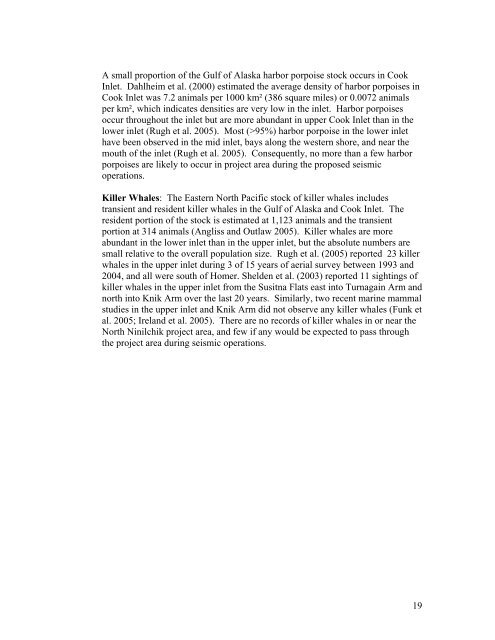IHA Application: Seismic Surveys in Cook Inlet by Marathon Oil ...
IHA Application: Seismic Surveys in Cook Inlet by Marathon Oil ...
IHA Application: Seismic Surveys in Cook Inlet by Marathon Oil ...
You also want an ePaper? Increase the reach of your titles
YUMPU automatically turns print PDFs into web optimized ePapers that Google loves.
A small proportion of the Gulf of Alaska harbor porpoise stock occurs <strong>in</strong> <strong>Cook</strong><br />
<strong>Inlet</strong>. Dahlheim et al. (2000) estimated the average density of harbor porpoises <strong>in</strong><br />
<strong>Cook</strong> <strong>Inlet</strong> was 7.2 animals per 1000 km² (386 square miles) or 0.0072 animals<br />
per km², which <strong>in</strong>dicates densities are very low <strong>in</strong> the <strong>in</strong>let. Harbor porpoises<br />
occur throughout the <strong>in</strong>let but are more abundant <strong>in</strong> upper <strong>Cook</strong> <strong>Inlet</strong> than <strong>in</strong> the<br />
lower <strong>in</strong>let (Rugh et al. 2005). Most (>95%) harbor porpoise <strong>in</strong> the lower <strong>in</strong>let<br />
have been observed <strong>in</strong> the mid <strong>in</strong>let, bays along the western shore, and near the<br />
mouth of the <strong>in</strong>let (Rugh et al. 2005). Consequently, no more than a few harbor<br />
porpoises are likely to occur <strong>in</strong> project area dur<strong>in</strong>g the proposed seismic<br />
operations.<br />
Killer Whales: The Eastern North Pacific stock of killer whales <strong>in</strong>cludes<br />
transient and resident killer whales <strong>in</strong> the Gulf of Alaska and <strong>Cook</strong> <strong>Inlet</strong>. The<br />
resident portion of the stock is estimated at 1,123 animals and the transient<br />
portion at 314 animals (Angliss and Outlaw 2005). Killer whales are more<br />
abundant <strong>in</strong> the lower <strong>in</strong>let than <strong>in</strong> the upper <strong>in</strong>let, but the absolute numbers are<br />
small relative to the overall population size. Rugh et al. (2005) reported 23 killer<br />
whales <strong>in</strong> the upper <strong>in</strong>let dur<strong>in</strong>g 3 of 15 years of aerial survey between 1993 and<br />
2004, and all were south of Homer. Shelden et al. (2003) reported 11 sight<strong>in</strong>gs of<br />
killer whales <strong>in</strong> the upper <strong>in</strong>let from the Susitna Flats east <strong>in</strong>to Turnaga<strong>in</strong> Arm and<br />
north <strong>in</strong>to Knik Arm over the last 20 years. Similarly, two recent mar<strong>in</strong>e mammal<br />
studies <strong>in</strong> the upper <strong>in</strong>let and Knik Arm did not observe any killer whales (Funk et<br />
al. 2005; Ireland et al. 2005). There are no records of killer whales <strong>in</strong> or near the<br />
North N<strong>in</strong>ilchik project area, and few if any would be expected to pass through<br />
the project area dur<strong>in</strong>g seismic operations.<br />
19
















